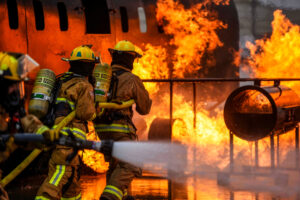The U.S. Chemical Safety and Hazard Investigation Board (CSB) released a report on March 24, marking the 20th anniversary of fatal explosions and fires at the BP America Texas City Refinery in Texas City, Texas. The March 23, 2005, explosions and fires at the BP America refinery led to 15 deaths, 180 injuries, and significant economic losses, according to the board.
Most of the CSB’s recommendations resulting from its investigation of the incident have been addressed, with one exception: revisions to the Occupational Safety and Health Administration’s (OSHA) process safety management (PSM) standard.
The CSB’s investigation found that on the day of the incident, during a unit start-up at the refinery, a distillation tower was overfilled with a flammable hydrocarbon liquid, triggering the opening of three emergency relief valves protecting the tower from high pressure. The flammable liquid discharged into a blowdown drum with a stack open to the atmosphere. The drum was overfilled with fluid, resulting in a geyser-like release out of the stack, which led to the explosions and fires.
Investigators also found that all the fatalities and many serious injuries occurred in or around nine contractor trailers that BP located near process areas—some as close as 121 feet away from the unit where the incident occurred.
In response, the American Petroleum Institute (API) revised its Recommended Practice (RP) 752, “Management of Hazards Associated with Location of Process Plant Buildings.” The board also suggested the industry seek safer alternatives to the atmospheric discharge of process chemicals. The API also revised its RP 521, “Guide for Pressure Relieving and Depressurizing Systems,” in response.
The CSB called on OSHA to revise its PSM standard to require that management-of-change (MOC) reviews be conducted for organizational changes that could impact process safety, including:
- Major organizational changes like mergers, acquisitions, or reorganizations;
- Personnel changes, including changes in staffing levels or staff experience; and
- Policy changes like operational budget cuts.
OSHA has a rulemaking to amend the PSM standard to address the risks of major chemical accidents. The agency issued a request for information (RFI) in December 2013 in response to an Executive Order from President Barack Obama (E.O. 13650). E.O. 13650 directed the Environmental Protection Agency (EPA) to update its risk management plan (RMP) regulations and OSHA to revise the PSM rule.
OSHA extended the comment period for its RFI in 2014 and conducted a Small Business Regulatory Enforcement Fairness Act (SBREFA) review in 2015. The Biden administration’s OSHA held a stakeholder meeting in 2022 and reviewed comments from the stakeholder review. So far, the agency hasn’t issued proposed revisions for the PSM rule. Amanda Wood Laihow, an acting assistant secretary, currently leads OSHA.
The CSB is an independent federal government board that investigates industrial chemical incidents. It doesn’t issue citations for regulatory violations or impose any penalties but instead makes safety recommendations to companies, industry groups, labor unions, and regulatory agencies, including the EPA and OSHA. The president appoints board members, who are subject to Senate confirmation.

